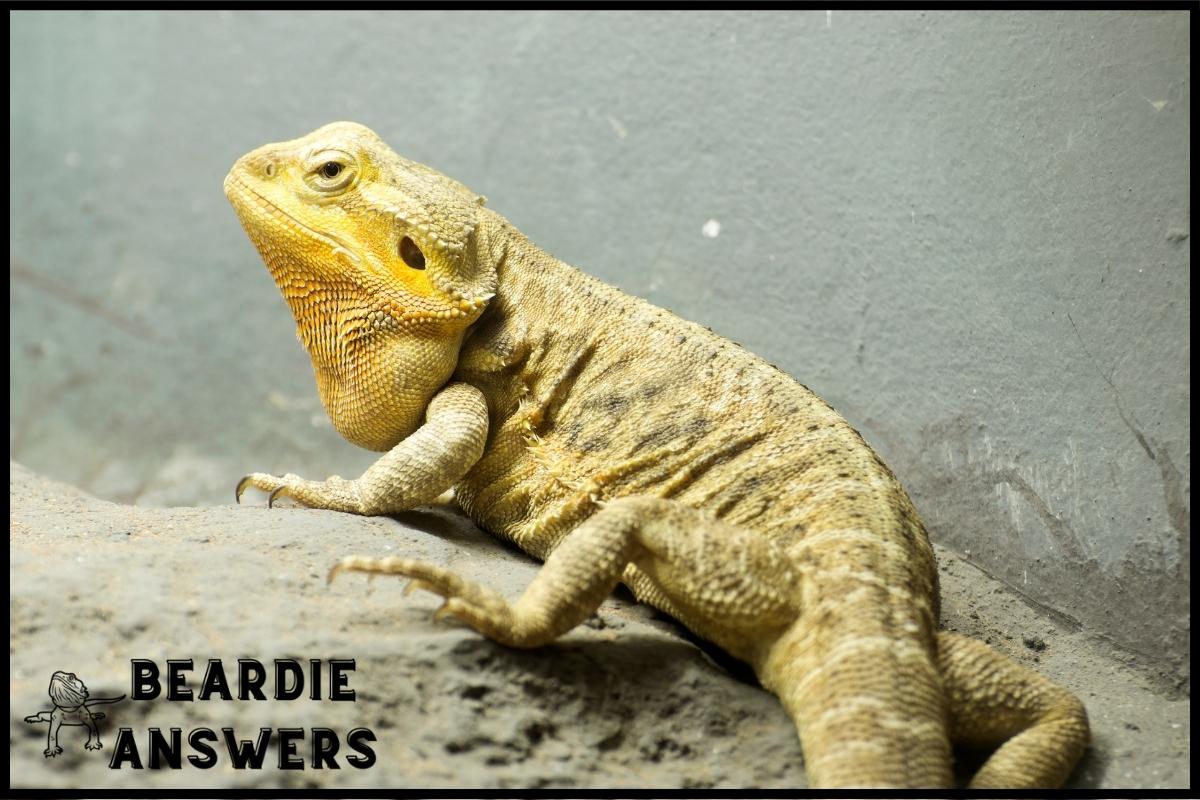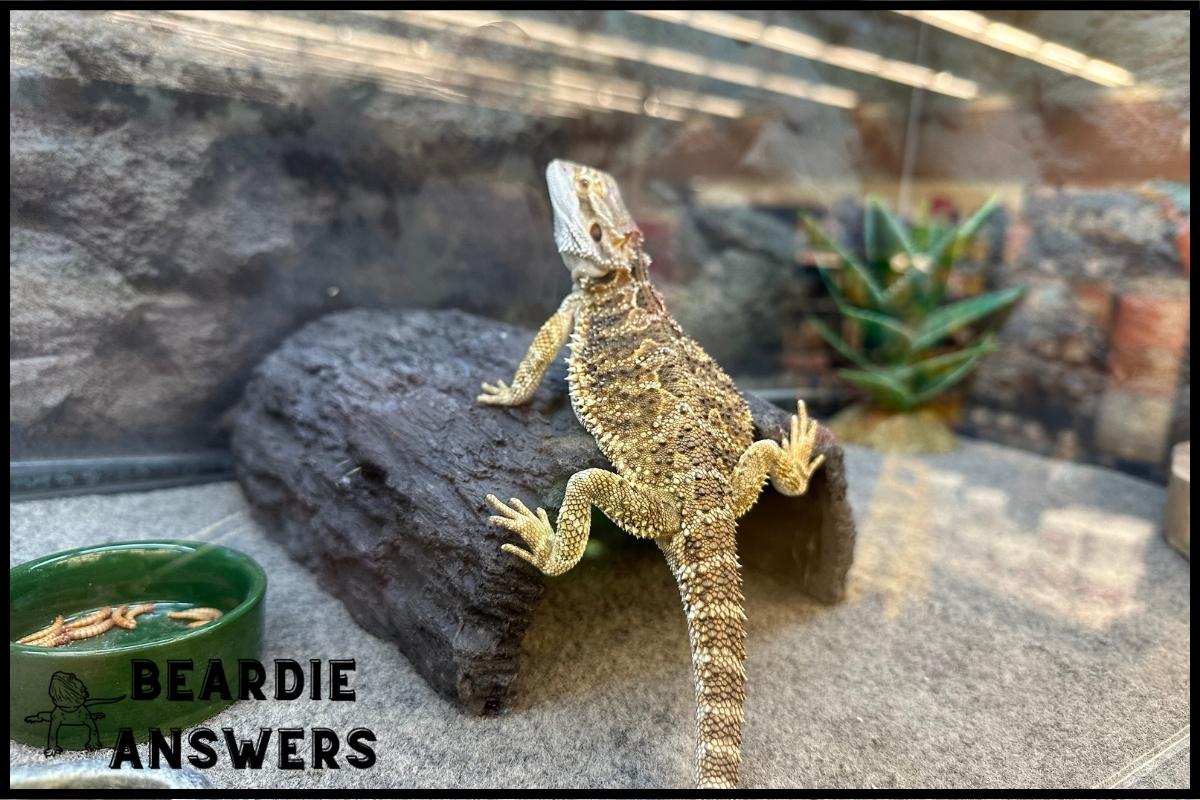A healthy bearded dragon tail should also have a clear separation from the body, indicating that it is not retaining fluid or experiencing any other health issues. Additionally, be sure to monitor your bearded dragon’s tail for any signs of shedding or injury.
What You'll Learn
Understanding The Anatomy Of A Bearded Dragon Tail
A bearded dragon’s tail is an essential part of their anatomy. It helps them balance and gives them the ability to swim. The tail also plays an important role in thermoregulation by helping the lizard absorb heat from its environment.
During shedding, a bearded dragon will lose old skin from their tails just as they do from the rest of their body. While this process can be uncomfortable for some lizards, it’s necessary in order to keep a healthy coat and regulate temperature.
Knowing how a healthy beardie tail should look is key to identifying any issue that may arise with your pet’s health. Transitioning into signs of a healthy bearded dragon tail, we must first understand what constitutes one.
Signs Of A Healthy Bearded Dragon Tail
A healthy bearded dragon tail is an important indicator of overall wellbeing. Proper tail grooming and diet nutrition are essential for keeping the tail in good condition.
Grooming should involve regular inspections to check for signs of injury or discoloration, as well as trimming any overgrown claws that could cause scratching or snagging. Nutritional considerations include making sure their diet consists of a variety of insects, vegetables, and occasional fruits; all meals should be supplemented with calcium and vitamin D3 to ensure proper growth and development.
It’s also essential to keep the environment clean by regularly changing bedding material and cleaning habitats (e.g., tanks). This helps maintain optimal temperatures, reduce stress levels, and prevent bacteria build-up which can lead to infection if left unchecked.
Additionally, it’s important to note that inadequate lighting may result in poor shedding patterns which can leave them more susceptible to external parasites like mites. By following these guidelines on tail grooming and dietary nutrition, owners will have a better chance at achieving a plump and vibrant looking beardie tail!
With this knowledge firmly in hand, we can now move onto exploring common causes of unhealthy tails.
Common Causes Of Unhealthy Tails
Having an understanding of the signs of a healthy bearded dragon tail is important for recognizing when something might be wrong. It’s also just as important to understand the common causes of an unhealthy tail so that you can take appropriate steps to prevent them from occurring in the first place.
Diet related issues usually occur when your beardie isn’t getting enough vitamins or minerals, which can cause their scales to become brittle and weak. Calcium deficiency is especially problematic since it affects muscle contraction and growth, leading to a thin or malformed tail. Ensuring they get a balanced diet with plenty of vegetables, fruits, insects and supplements will help keep their tails plump and strong.
Environmental factors such as temperature fluctuations and humidity levels can also play a role in how healthy your beardie’s tail looks over time. The optimal temperatures should range between 75-85°F during the day, with cooler nights around 70°F. Proper lighting such as UVB lamps should also be provided along with good air circulation to ensure they stay cool during hot weather. Low humidity levels below 40% should also be maintained at all times in order to avoid skin irritation on their tails or other parts of the body.
Keeping these considerations in mind, combined with regular checkups from vets whenever necessary, will go a long way towards ensuring your beardie stays happy and healthy throughout its life cycle – including having a beautiful, vibrant tail! With this knowledge under your belt, let’s move on to tips for maintaining a healthy tail going forward.
Tips For Maintaining A Healthy Tail
Maintaining the health of a bearded dragon’s tail can be an important part of their overall wellbeing. But it isn’t always easy to know what steps need to be taken in order to keep their tails looking and feeling strong.
To ensure that your pet’s tail is healthy, there are certain measures you should take—including proper nutrition, environmental enrichment and regular monitoring for any potential signs of injury or discoloration.
When it comes to diet, providing your bearded dragon with a nutritionally balanced meal plan will go a long way towards ensuring their tail stays plump and healthy. This means giving them plenty of insects as well as fruits and vegetables rich in vitamins and minerals. Additionally, they benefit from supplements like calcium powder which helps strengthen weak bones in their tails.
Environmental enrichment plays another crucial role in maintaining the health of a beardie’s tail. Creating an environment that encourages natural behavior is essential for keeping them active, allowing them to exercise regularly so their tails stay strong and flexible.
With this combination of good nutrition and ample opportunity for physical activity, your pet’s tail should remain healthy over time. So let’s move on now to learning about how to recognize when something has gone wrong – specifically injuries or discolorations resulting from poor care – and how best to treat them accordingly.
Tail Injuries And Treatments
Tail injuries and treatments are an important part of keeping your bearded dragon healthy. Injuries can range from minor to severe, so it is important to know what signs to look for and how to treat them properly.
The most common tail injury that can occur in a bearded dragon is tail shedding. This occurs when the lizard sheds its old skin and reveals new scales underneath. It usually happens as the animal grows, but if there’s too much excessive shedding, this could be a sign of illness or stress in the animal.
Tail coloring can also change due to environmental conditions such as temperature changes or lack of nutrition. If you notice any discoloration on your pet’s tail, take them to their vet right away.
When treating a bearded dragon’s tail injury, it is important to do the following:
Cleanse
- Wash off any dirt or debris gently with warm water and mild soap
- Use antiseptic wipes around the wound area
- Apply antibiotic ointment after cleaning
Cover
- Cover wounds with sterile gauze pads
- Secure bandage with tape or use self-adhesive bandages
Monitor
- Monitor healing process closely over time
- Change bandages regularly until healed completely
It is essential to pay close attention to your bearded dragon’s tail health; early detection and treatment of any issues can help prevent more serious problems down the line. Knowing when to seek veterinary care for your furry friend will ensure they stay happy and healthy for years to come!
When To Seek Veterinary Care For Your Bearded Dragon’s Tail
Once you have a good understanding of tail injuries and treatments, it is important to know when to seek veterinary care for your bearded dragon’s tail.
If any signs of injury or discoloration are present on the plump tail, medical attention should be sought immediately.
In addition, if your beardie’s tail length is below what would normally be expected for its age, this could indicate an underlying health issue and should not be overlooked.
Another thing to keep an eye out for is abnormal shedding of the skin along the bearded dragon’s tail. While some shedding is normal as they grow older, excessive or patchy pieces coming off can signal that something isn’t right.
Additionally, pay close attention to how often the shed occurs; more frequent sheds may also warrant a trip to the vet.
If any changes in appearance occur suddenly or seem too drastic compared to their regular healthy state, it’s best to take them into a veterinarian specialized in reptiles so they can properly assess the situation and provide treatment if needed.
Conclusion
In conclusion, having a healthy bearded dragon tail is essential to the wellbeing of your pet.
As an owner, it’s important to understand the anatomy and signs of health in order to provide proper care and attention for your companion.
With regular inspections and preventive measures such as creating a safe environment, you can ensure that your beloved beardie has a strong, vibrant tail with no sign of injury or illness – truly something to marvel at!
Taking care of the tail can seem daunting but with lots of love and commitment from you, their guardian angel, it will be easier than ever – almost like a walk in the park!

Hi! My name is Bryan, I am the “one behind the words” here are BeardieAnswers.com. I believe that providing quality care and nutrition is the best way to ensure the health of your pet. Every beardie is special and deserves the best care and attention. If you have questions about your bearded dragon, please don’t hesitate to ask! View My Full Author Page




